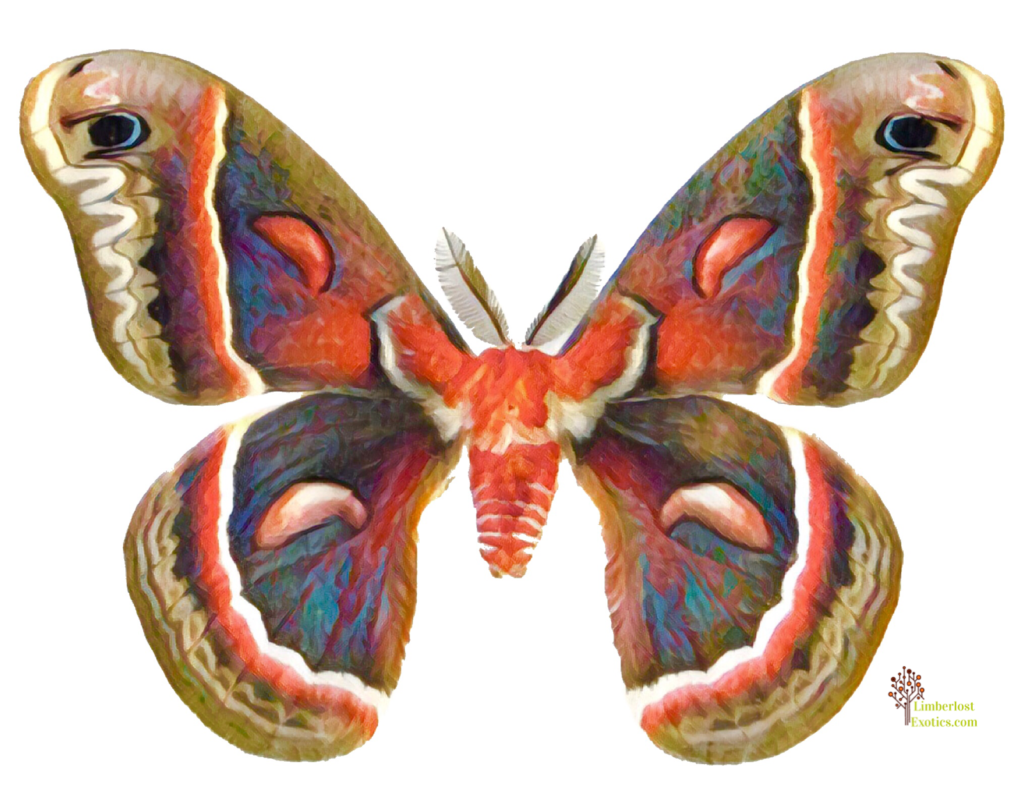 Hyalophora cecropiaHistory:
Hyalophora cecropiaHistory:Also known as the robin moth this is the largest North American Saturniidae with an impressive wingspread of up to 7 inches. The first time I ever saw this species was when I was thirteen and it really made an impression. Its hard to believe that such a large and royal colored moth exists as far north as Canada. Cecropia are the second most recognized species by the general public. In part it is most likely due to its size, but also the striking markings and ability to occur in residential and developed areas. It has been my observation that cecropia, and Polyphemus do well in developed areas. They benefit from the wide use of ornamental tree and shrubs planted around homes as they are polyphagous. This species is wide ranging as far west as California and south to Florida. This species is univoltine but regardless of its range produces a single brood. Cecropia are noted to have population surges from time to time, but never have been considered a pest species. They appear to favor areas of disturbance where young sapling trees are growing either due to logging or development. Adult moths smell sweet similar to that of freshly cut cherry logs. It was my thought that they may be exuding chemicals consumed in the larval stage on cherry, but this smell is possessed by adults not reared on cherry.
Reproduction:Adult moths lack functional mouthparts or digestive system and therefore they live only for about two weeks. This strategy seems odd as many other species of moths and butterflies feed throughout the period they are adults, but allow me to break down the evolutionary advantages that allow them to do this. The female moth emerges from its cocoon with fully developed ova which allows it to be ready to receive sperm from a male and begin depositing eggs the same night that it hatches. Female seen below mating on cocoon she emerged earlier from.
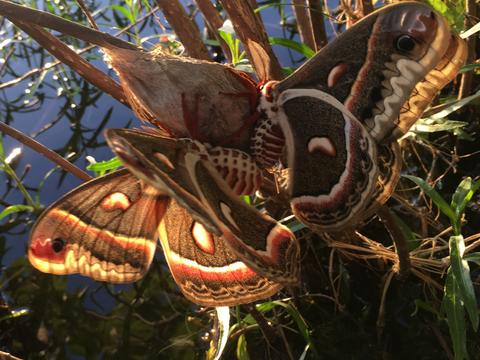 hyalophora cecropia pair mating on cocoon female emerged from
hyalophora cecropia pair mating on cocoon female emerged fromMale moths emerge with large feathery antennae that allow them to detect female pheromones up to a mile away. Males cover long distances flying in a zigzag pattern until pheromone particles have been detected. Females begin “calling” around 2:00a.m. and continue till dawn. By releasing such effecting means of detection females do not waste energy flying about seeking mates and reserve all their energy for seeking out host plants appropriate for ova positing. Saturniidae regardless of species are by no means ever abundant in the environment. The ability of the males to detect females of the same species from long distances allow them to maintain populations under low density. Female moths frequently will deposit eggs onto the same host plant that they developed on to reduce their weight to allow them to fly away. Large female cecropia in particular are often so heavy that they will deposit eggs on anything to reduce their weight enough to fly away.
Eggs:large females are capable of laying up to three hundred eggs, but the average is two hundred. Host plant specificity allows the developing larva to more efficiently convert the consumed biomass into fat reserves and tissue. This influences the size of the adult and the possible number of ova that females can carry. Stunted females can carry up to as few as thirty – fifty eggs. Cecropia in my opinion have a specificity to black cherry and produce the largest adults on this. Some other host plants I have personally observed larva feeding on are Apple, Silver maple, Norway maple, Red maple, plum, Elder berry, Oak, and Red twigged dogwood. Eggs are deposited on the undersides of host leaves in rows and groups of three – eight. The eggs can hatch in as little as nine days, or as long as 14 days depending on temperature. They are oval in shape and are tinged with the residual brown glue that adheres the eggs to the leaf surface.
 Hyalophora cecropia eggs
Hyalophora cecropia eggsFertile eggs that are about to hatch take on a chalkier appearance and darken slightly.
Larva:Larva of this species emerge black and covered in fine bristled hairs.
 hyalophora cecropia larva first instar
hyalophora cecropia larva first instarThey will consume all or part of the egg shell and soon after will begin to consume the leaves they find themselves upon. Larva of all saturniidae have 5 instars and cecropia are gregarious up to their 3rd instar. Larva in their second instar are yellow with black shiny spines.
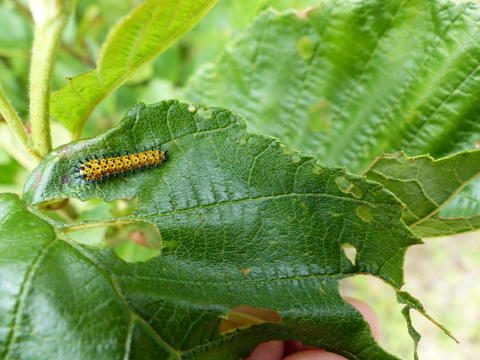 hyalophora cecropia larva second instar
hyalophora cecropia larva second instarThe third instar larva are bright green with yellow tubercles on the top, light blue on the sides and four red clubbed tubercles on the front.
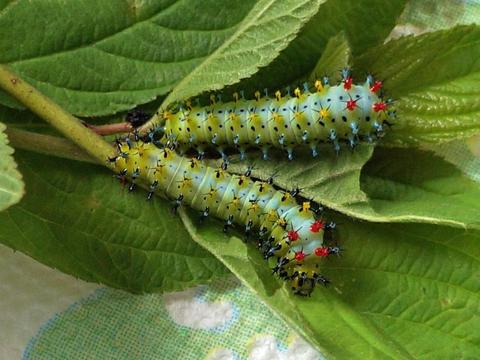 hyalophora cecropia larva third instar
hyalophora cecropia larva third instarThe Fourth and fifth instar take on a more bluish green hue, yellow clubbed tubercles on the top, blue tubercles on the side, and the four clubbed knobs on the top front change from red to orange with black spines.
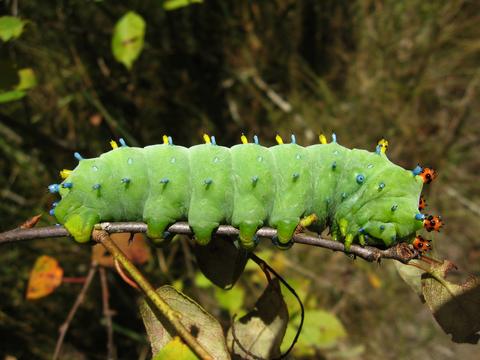 hyalophora cecropia larva fifth instar
hyalophora cecropia larva fifth instarLarva of this species reach a great size and are as fat around as a mans thumb. Once they have reached the fifth instar they continue to consume leaves at an incredible rate until they are ready to pupate.
Cocoon: hyalophora cecropia cocoon
hyalophora cecropia cocoonCecropia spin an oblong shaped cocoon attached lengthwise to one side. The color of the silk is influenced by the host plant and cocoons found on cherry and apple are dark brown whereas the ones found on elderberry, and oak tend to be very light tan. They prefer to position the cocoon at the base of a major branch or low down on the host plant, however I have observed cocoons spun on the tips of branches. Cocoon structure is of two styles, baggy and tight. This characteristic does not seem to be influenced by anything in particular and does not indicate the size of the adult produced. Cocoons have an outer silken structure and an egg shaped inner chamber that houses the pupa. The cocoon is an amazing feat of engineering considering that its composed entirely of silk. This species does not incorporate host leaves for structure and you will observe that the size of the caterpillar is greatly reduced by the very act of spinning its cocoon. Cocoons are constructed with a looser end that is utilized by the emerging moth and is oriented at the highest gradient point.
Pupa:The pupa of this species is heavily textured and brown with reddish hues suffused throughout.
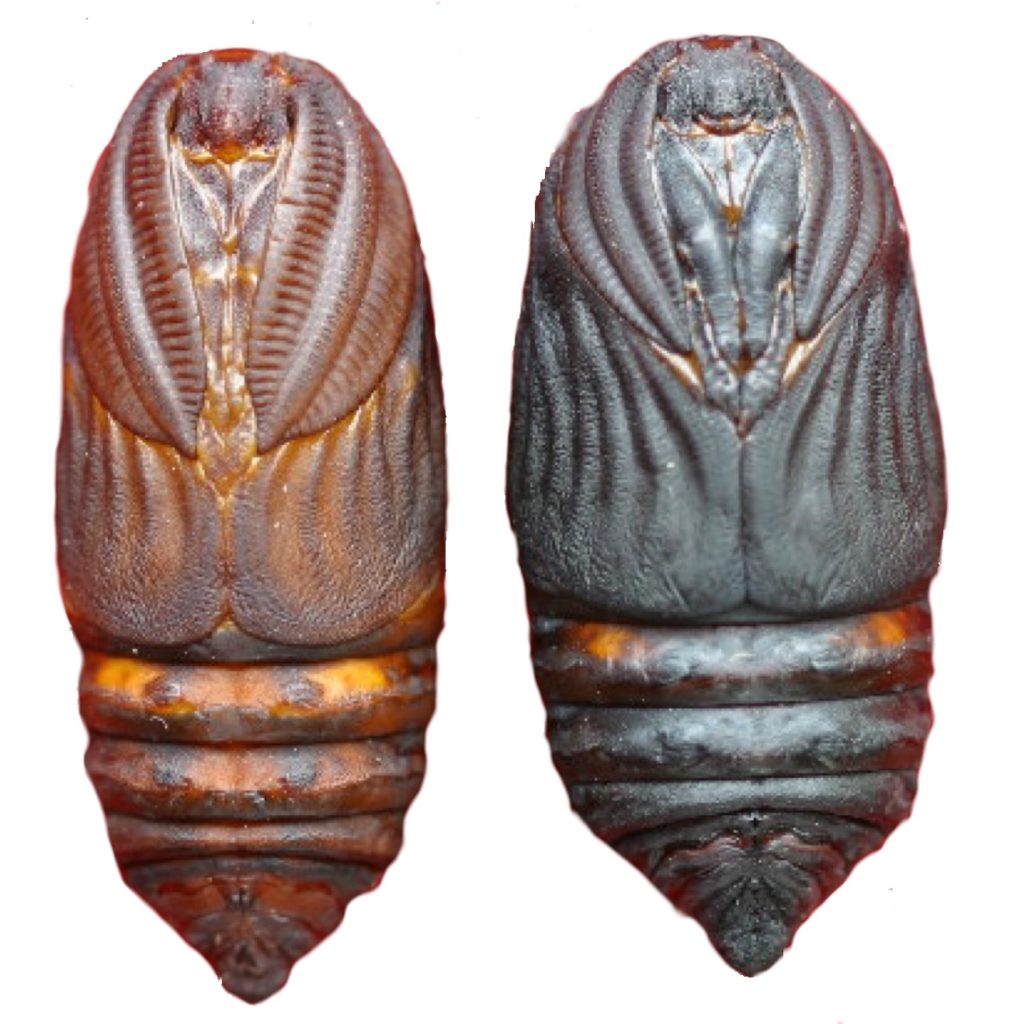 Male pupa on left female pupa on right
Male pupa on left female pupa on rightMale and female pupa are easy to sex as males have nearly no gap between the outline of their front legs and the edges of the antenna lines. Pupa when warmed will wriggle enough to shake the cocoon about. This is sometimes a helpful tool to determine if a wild collected cocoon is viable.
Eclose:Cecropia emerge from late May to mid June during the late morning early afternoon. Adults frequently use the cocoon as a support to hang and dry their wings. As nocturnal Saturniidae they wait till nightfall to take flight. Females reserve flight until they have been mated. It’s a general rule of thumb that if you capture a female at lights that she most likely has been mated and therefore eggs produces should be fertile.
Mortality factors:Saturniidae larva are large and for most species defenseless. Birds readily seek out both the larva and adult moths. Moths drawn to night lights sit dazzled by the source where they are then picked off buildings once dawn emerges. Bats normally feed on small insects but will not pass up a large moth, leaving only wings as evidence. There are many parasitic fly and wasp species that utilize the larva as a host.
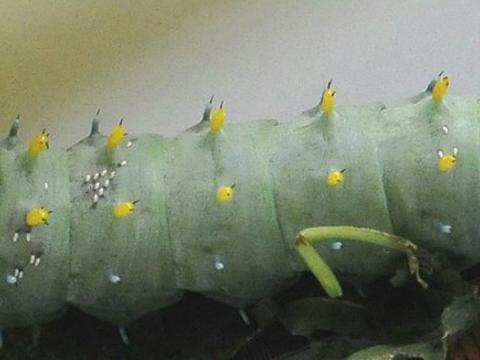 hyalophora cecropia parasite eggs
hyalophora cecropia parasite eggsCecropia and all North American Lepidoptera have taken heavy tolls due to the release of the tachinid fly used in attempt to control gypsy moth populations. Larva can experience high mortality rates due to fungal, bacterial, and viral infection. The larva in nature have no real capacity to combat high density issues and have adapted to leave gregarious habits by the 3rd instar. Pupa are consumed in the winter by hungry squirrels, mice, and woodpeckers who can easily rip open the cocoons.
Rearing notes:Cecropia are easy to rear under low densities only. You must make sure that if the larva is raised indoors that there is plenty of ventilation, otherwise they quickly succumb to viral, or fungal infections. In general, its best to sleeve rear them directly on the host plant. The larva has an extremely long development period (2-3 months) and high temps assist with getting them matured before it becomes cold. I like to sleeve 3-4 larva on black cherry in six foot sleeves. By doing this the larva rarely bump into each other and develop to a large size. If the rearing conditions are too crowded not only do you invite infection, but the constant disturbance of other larva stunt the entire brood. Like previously stated in the wild larva disperse after the third instar and would not likely encounter another larva of their species under natural conditions.